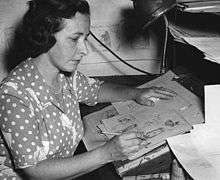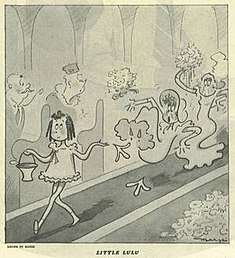Marge (cartoonist)
Marjorie Henderson Buell (née Marjorie Lyman Henderson, December 11, 1904 – May 30, 1993) was an American cartoonist who worked under the pen name Marge. She was best known as the creator of Little Lulu.
| Marge | |
|---|---|
 Marge working on a sketch of her most famous character, Little Lulu | |
| Born | Marjorie Lyman Henderson December 11, 1904 Philadelphia, Pennsylvania |
| Died | May 30, 1993 (aged 88) Elyria, Ohio |
| Nationality | American |
Notable works | Little Lulu |
Early life
Marjorie Lyman Henderson was born in 1904 in Philadelphia to Horace Lyman Henderson and Bertha Brown Henderson.[1] She and her two sisters grew up on a farm outside Malvern.[2] The three sisters drew comics for birthday cards and family events while they were growing up.[3] At the age of 8 she began selling her work to friends.[4] She attended then graduated from Villa Maria Academy HiIgh School in 1921.
Career
At 16 she sold her first cartoon to the Public Ledger.[5] Her work appeared in humor magazines and other periodicals, including Collier's, Judge, Life.[6] She also created illustrations for Country Gentleman and Ladies' Home Journal. By the late 1920s she worked under the name "Marge" and had a syndicated comic strip, The Boy Friend,[5] her first syndicated comic strip, which ran from 1925 through 1926. This and another strip of hers, Dashing Dot, both featuring female leads.[7] Marge was friends with Oz author Ruth Plumly Thompson and illustrated her fantasy novel King Kojo (1933).
In 1934 The Saturday Evening Post requested Buell to create a strip to replace Carl Anderson's Henry.[6] Buell created a little girl character in place of Henry's little boy as she believed "a girl could get away with more fresh stunts that in a boy would seem boorish". The first single-panel instalment ran in the Post on February 23, 1935; in it, Lulu appears as a flower girl at a wedding and strews the aisle with banana peels. The single-panel strip continued in the Post until the December 30, 1944, issue, and continued from then as a regular comic strip.[7] Buell retained the rights, unusual for the time. Buell marketed Little Lulu widely throughout the 1940s. Buell herself ceased drawing the strip in 1947, and in 1950 Little Lulu became a daily syndicated by Chicago Tribune–New York News Syndicate and ran until 1969.[8] After she stopped drawing the strip, Buell herself only drew Lulu for the lucrative Kleenex advertisements.[9]

Paramount Pictures approached Buell in 1943 with a proposal to develop a series of animated shorts. She traveled to New York to meet with Paramount executives and tour the animation facilities, and there was introduced to William C. Erskine, who became her business representative.[9]
Thereafter Little Lulu was widely merchandised,[10] and was the first mascot for Kleenex tissues;[7] from 1952 to 1965 the character appeared in an elaborate animated billboard in Times Square in New York City[11] designed by Artkraft Strauss.[9]
The character appeared in comic books, animated cartoons, greeting cards and more. Little Lulu comic books, popular internationally, were translated into Arabic, Dutch, Finnish, French, Japanese, Norwegian, Portuguese, Spanish, Swedish and Greek. Buell stopped drawing Little Lulu in 1947, and the work was continued by others, while she kept creative control. Sketching and writing of the Little Lulu comic book series was taken on by John Stanley, who later drew Nancy and Sluggo. Buell sold her Little Lulu rights to Western Publishing when she retired in 1971.
Personal life
On 30 January 1935, she married Clarence Addison Buell[9] who had a career in the Bell Telephone Company. The two reached a compromise in their career ambitions, in that the husband agreed to turn down promotions that would result in relocation, and the wife would keep her creation enough in check that she would be available for her children.[5] The couple had two sons: Larry, born in 1939; and Fred, born in 1942.
She shied from the spotlight, rarely giving interviews or allowing publication of photos of herself.[9] She also shied away from politics, and resisted requests from her sons to include progressive elements such as a black playmate for Lulu.[5]
After the sale of the Lulu copyrights in 1971, the Buell couple retired to Ohio, where their son Larry resided.[9] Buell died on May 30, 1993,[6] of lymphoma in Elyria, Ohio.[12] Buell's son Larry is a professor of American Literature at Harvard, and her son Fred is a professor of English at Queens College.[5]
Legacy
In July 2006, Buell's family donated the "Marge Papers" to the Schlesinger Library at Harvard University. The papers include a collection of fan mail, comic books, scrapbooks of high points in Lulu's history and a complete set of the newspaper cartoons.[5]
In 2005, Heritage Auctions sold the original art to the first Little Lulu panel for $9,200. [13] In recent years, Buell's original art from Little Lulu panels regularly bring between $2,000-$3,000 at auction.
References
- "Buell, Marjorie Henderson (1904-1993), cartoonist | American National Biography". www.anb.org. doi:10.1093/anb/9780198606697.article.1701668. Retrieved 2019-03-26.
- "Buell, Marjorie Henderson (1904-1993), cartoonist | American National Biography". www.anb.org. doi:10.1093/anb/9780198606697.article.1701668. Retrieved 2019-03-26.
- "Pennsylvania Center for the Book". pabook.libraries.psu.edu. Retrieved 2019-03-26.
- "Pennsylvania Center for the Book". pabook.libraries.psu.edu. Retrieved 2019-03-26.
- Gewertz 2006.
- Reynolds 2003, p. 95.
- Robbins 2013, p. 452.
- Robbins 2013, p. 453.
- Gotwals 2010.
- Robbins 2013, p. 455.
- Sagalyn 2001, p. 335.
- Collins, Glenn (1993-06-03). "Marjorie Buell, 88, Pioneer Cartoonist Of 'Little Lulu' Strip". The New York Times. ISSN 0362-4331. Retrieved 2019-03-08.
- "Marge Buell - The First Little Lulu Panel Page Original Art, dated 2-23-35 (Saturday Evening Post, 1935)", Heritage Auctions
Sources
- Collins, Glenn (1993-06-03). "Marjorie Buell, 88, Pioneer Cartoonist Of 'Little Lulu' Strip". New York Times.CS1 maint: ref=harv (link)
- Gewertz, Ken (2006-11-02). "Little Lulu comes to Harvard". Harvard Gazette. Archived from the original on 2007-02-23.CS1 maint: ref=harv (link)
- Gotwals, Jennifer (2010). "Marge and Lulu: The Art of the Deal". Hogan's Alley. Archived from the original on 2013-05-01. Retrieved 2014-12-29.CS1 maint: ref=harv (link)
- Reynolds, Moira Davison (2003). "Marjorie Henderson Buell". Comic Strip Artists in American Newspapers, 1945–1980. McFarland. pp. 95–96. ISBN 978-0-7864-8150-7.CS1 maint: ref=harv (link)
- Robbins, Trina (2013). "Little Lulu". In Duncan, Randy; Smith, Matthew J. (eds.). Icons of the American Comic Book: From Captain America to Wonder Woman. ABC-CLIO. pp. 452–457. ISBN 978-0-313-39923-7.CS1 maint: ref=harv (link)
- Taylhardat, Karim. La Pequeña Lulu/The Little Lulu & M. Henderson, Madrid, Spain: Ediciones Sinsentido, 2007.
External links
- Papers, 1856-1994. Schlesinger Library, Radcliffe Institute, Harvard University.